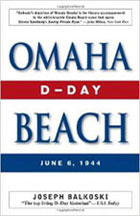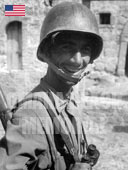| Plan a trip : |  |
| |
|
 |
Raymond S. HOBACK - 29th Division.
Bedford Boys Fallen - Raymond Samuel HOBACK never had a chance to reach 100 years old today. Instead, he sacrified his life for our freedom... Raymond may have made it out of his landing craft, but he never made it to shore. Others recall seeing his body in the water. Bedford also failed to make in on the beach. He was killed by an exploding 88mm shell. Their time in the battle could be measured in minutes... [American D-Day facebook] Read more...
[Posted: 2020-01-21 22:40:05]
Bedford Boys Fallen - Raymond Samuel HOBACK never had a chance to reach 100 years old today. Instead, he sacrified his life for our freedom... Raymond may have made it out of his landing craft, but he never made it to shore. Others recall seeing his body in the water. Bedford also failed to make in on the beach. He was killed by an exploding 88mm shell. Their time in the battle could be measured in minutes... [American D-Day facebook] Read more...
[Posted: 2020-01-21 22:40:05]
RIP - Robert GIGUERE - Navy.
It is with heavy heart we learn the passing of Mr. Robert GIGUERE, a veteran of D-Day (Normandy)... He was 93... Four days earlier, Giguere rode across the choppy English Channel toward the Normandy coast with the Sixth Naval Beach Battalion. When his carrier grounded on the beach, a Teller mine detonated from beneath and tore through the ship's hull, Killing several soldiers below deck... [American D-Day facebook] Read more...
[Posted: 2020-01-21 22:58:23]
It is with heavy heart we learn the passing of Mr. Robert GIGUERE, a veteran of D-Day (Normandy)... He was 93... Four days earlier, Giguere rode across the choppy English Channel toward the Normandy coast with the Sixth Naval Beach Battalion. When his carrier grounded on the beach, a Teller mine detonated from beneath and tore through the ship's hull, Killing several soldiers below deck... [American D-Day facebook] Read more...
[Posted: 2020-01-21 22:58:23]
| 1 - 2 / 25 news |
| BRODISH WILLIAM J 27TH ORD BOMB DISP SQ |
Honored by Constance Brodish
[Posted: 2024-06-12 20:46:41]
| MULVEY JOHN M 299TH ENG COMBAT BN |
Honored by Diane Mulvey
[Posted: 2024-06-06 18:50:12]
| 1 - 2 / 138 messages |
| OMAHA BEACH MEMORIAL - TESTIMONIES | |
 |
Partager |
| Captain John R. Armellino 1st Infantry Division 16th Infantry Regiment 3rd Battalion Company L |
|
Upon our arrival at our destination off the coast of France, we were given orders to disembark from the mother ship onto the landing craft. My men went over the side onto rope ladders hanging from the ship. The soldiers, fully equipped, climbed down these ladders into the landing craft, which were rolling and turning in the rough waters of the English Channel. We started towards Omaha Beach. One of my landing craft was swamped by the violent seas and sank. To this day, I don’t know how many of those men were lost. Since we were the first combat wave, there was complete silence on the way to the beach. You could hear a pin drop. We didn’t know what to expect when we landed. We soon found out... About a quarter-mile from the beach, all hell broke loose. The landing craft came under an intense attack, including mortar and artillery fire. One of my landing craft took a direct hit from enemy fire as it was unloading onto the beach. Half the men on this craft had already left the boat when it was hit. Some of these men crossed the beach. The remainder were either killed or wounded. As we landed, enemy fire peppered the ramps as they were lowered to allow my men to disembark and cross the 200 yards of open beach. The German pillboxes and machine-gun nests were laying a vicious crossfire on the beach. Many men were cut down as they left the landing craft. Small-arms, mortar, and artillery fire were all concentrated on the landing area, but we suffered our greatest casualties just after touching down because of the crossfire of the German automatic weapons. Few of the landing craft were able to make a dry landing. Most of them grounded on sand bars 50 to 100 yards off the beach. The water was neck deep. Some men climbed over the sides of the landing craft trying to avoid enemy fire. We lost some of these men because in the excitement they failed to open their garrison belts and the weight of their equipment took them under water. Some of these men drowned while others shed the equipment and swam to shore. The water was loaded with obstacles to which mines were attached. Those who reached shore started running across the beach through heavy machine-gun crossfire, mortars, and artillery fire. We headed towards a bluff to give us cover. I lost many of those young soldiers who joined my company right before the invasion in England. They had no fear and failed to hit the ground after every few yards running directly for cover. The more seasoned men hit the ground very often as a result avoided being hit by enemy fire. After reaching the cover of the bluff, I began to reorganize my Company. I had approximately 125 men left of the 200 I started with. I directed my Lieutenants to organize their sections for the start of the attack to knock out the pillboxes and to advance to and capture our objective - Colleville-sur-Mer. I directed one of my Officers, Lieutenant Monteith, to move his section up a draw to take out a pillbox that was laying heavy automatic fire on the beach. The other sections were ordered to move up on his flanks towards the Village of Colleville-sur-Mer. Lieutenant Monteith accomplished his mission, knocking out the pillbox, and taking several German prisoners. In the process of doing so, Lieutenant Monteith was killed by German automatic fire coming from this bunker. He had exposed himself to enemy fire time and time again while repeatedly standing up to lead his section. I recommended Lieutenant Monteith for the Congressional Medal of Honor, which he received posthumously for his brave deeds. Posted: July 16, 2011 Copyright: Laurent Lefebvre |
|

